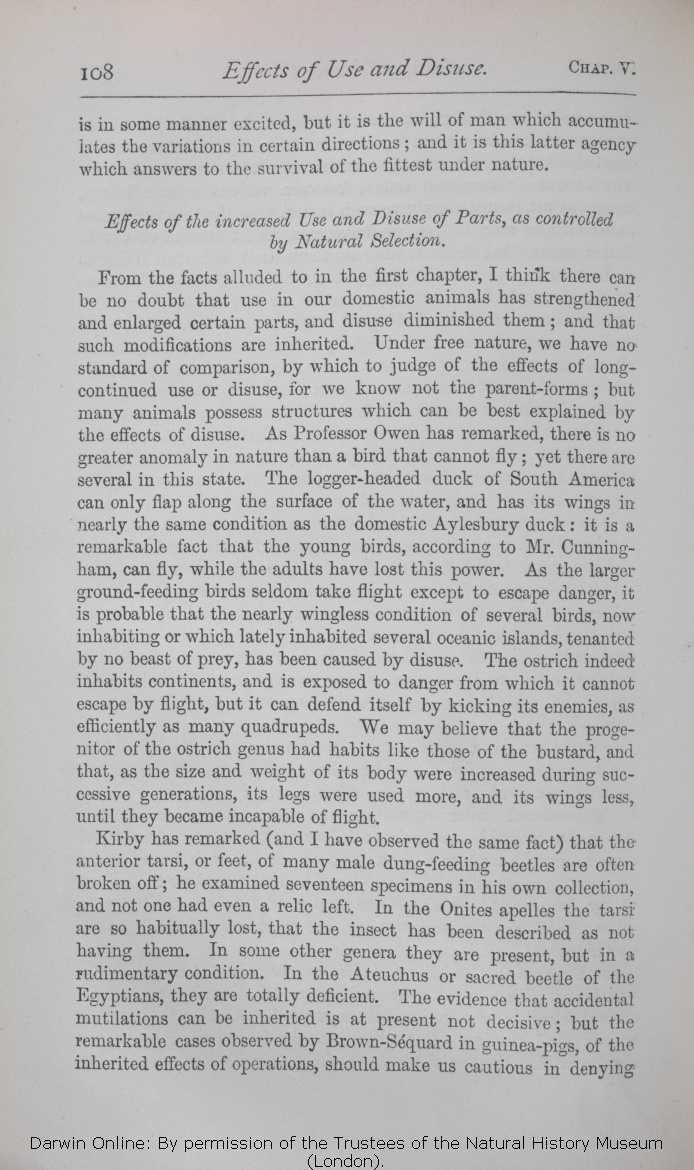the will of
man
which | which 1872 |
| acting either consciously or unconsciously, 1866 1869 |
| accumulates 1869 1872 | | accumulating 1866 |
| certain 1869 1872 | | cretain 1866 |
| ..... 1869 1872 | | definite 1866 |
| directions; and it is this latter agency which answers to the survival of the fittest under nature. 1872 |
| directions. 1866 |
| directions, and this answers to the survival of the fittest under nature. 1869 |
|
Effects
|
Effects
1866 1869 1872 | |
Effects
1859 1860 1861 |
|
of
1866 1869 1872 | |
of
1859 1860 1861 |
|
the increased Use and Disuse of Parts, as controlled by Natural Selection
. 1872 |
|
Use and Disuse
.—
1859 1860 1861 |
|
Use and Disuse, as controlled by Natural Selection. 1866 |
|
Use and Disuse, as controlled by Natural Selection
. 1869 |
|
From the facts alluded to in the first chapter, I think there can be
no | no 1866 1869 1872 | | little 1859 1860 1861 |
| has strengthened 1872 | | strengthens 1859 1860 1861 1866 1869 |
| enlarged 1872 | | enlarges 1859 1860 1861 1866 1869 |
| diminished 1872 | | diminishes 1859 1860 1861 1866 1869 |
| ..... 1869 1872 | | can 1859 1860 1861 1866 |
| possess 1872 | | have 1859 1860 1861 1866 1869 |
| best explained 1872 | | explained 1859 1860 1861 1869 | | ex- plained 1866 |
| duck: it is a remarkable fact that the young birds, according to Mr. Cunningham, can fly, while the adults have lost this power. 1872 |
| duck. 1859 1860 1861 1866 1869 |
| it is probable 1872 |
| I believe 1859 1860 1861 1866 1869 |
| ..... 1872 | | which 1859 1860 1861 1866 1869 |
| inhabiting 1872 | | inhabit 1859 1860 1861 1866 1869 |
| which 1872 | | have 1859 1860 1861 1866 1869 |
| continents, 1872 | | continents 1859 1860 1861 1866 1869 |
| ..... 1872 | | by kicking 1859 1860 1861 1866 1869 |
| by kicking its 1872 |
| from 1859 1860 1861 1866 1869 |
| efficiently 1872 | | well 1859 1860 1861 1866 1869 |
| many 1872 | | any 1859 1860 1861 1866 1869 |
| OMIT 1872 |
| of the smaller 1859 1860 1861 1866 1869 |
| believe 1861 1866 1869 1872 | | imagine 1859 1860 |
| ..... 1861 1866 1869 1872 | | early 1859 1860 |
| genus had 1861 1866 1869 1872 | | had 1859 1860 |
| the 1872 | | a 1859 1860 1861 1866 1869 |
| that, 1866 1869 1872 | | that 1859 1860 1861 |
| OMIT 1872 |
| natural selection increased in successive generations 1859 1860 1861 1866 1869 |
| body 1872 | | body, 1859 1860 1861 1866 1869 |
| were increased during successive generations, its 1872 |
| its 1859 1860 1861 1866 1869 |
|
|
Kirby has remarked (and I have observed the same fact) that the anterior tarsi, or feet, of many male dung-feeding beetles are
..| ..... 1872 | | very 1859 1860 1861 1866 1869 |
| beetle 1859 1860 1861 1869 1872 | | bettle 1866 |
| not decisive; 1872 |
| very scanty; 1861 |
| not quite decisive; 1866 1869 |
| cases 1872 | | case 1861 1866 1869 |
| in guinea-pigs, of the inherited effects of operations, 1872 |
| of epilepsy produced by injuring the spinal chord of guinea-pigs, being inherited, 1861 1866 |
| of inherited epilepsy in guinea-pigs, caused by an operation performed on the spinal chord, 1869 |
|









